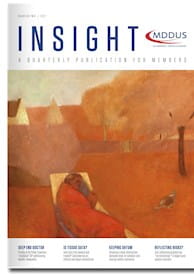
EVERYONE makes mistakes. That’s why keyboards have a delete button and (for readers of my vintage) why Tippex was invented – though please don’t use it retrospectively to amend handwritten clinical records.
Dentistry unfortunately provides many working examples of things that can’t be so easily fixed. After all, using rapidly rotating or sharp instruments within a confined, mobile environment is a bit of a high-wire act. Accidental pulp exposures, root perforations and needlestick injuries can happen in the blink of an eye and are often irreversible.
Most practitioners – once their heart-rate has slowed – will provide the patient with a full and empathetic explanation of what has happened. However, these conversations are never easy. Life being life, the incident occurs when time or the patient’s forbearance is at a premium. There may also be a fear of litigation, conflict or censure and the temptation to just keep ‘shtum’ may be keen whilst offering a silent prayer to the gods of teeth. After all, most of us have inherited historic dental catastrophes about which the patient is blissfully unaware. Maybe this case will be similarly blessed.
However, the harsh reality is that most errors come out in the wash. Usually the patient will return reporting symptoms, at which point the treating dentist has to come clean. Worse still, the problem may be drawn to the attention of the patient by another practitioner (more of which later).
Lack of forthrightness at the time of the incident has always tended to damage the relationship of trust, impede the resolution process and, if matters escalate, prejudice the practitioner’s defence. However, there is now an increased likelihood that the issue of candour will be the subject of particular scrutiny.
A DUTY OF CANDOUR
Legislation has recently been enacted in England (incorporating specific reporting obligations) and will be introduced in Scotland which obligates health service providers, amongst others, to follow designated procedures following adverse outcomes above a certain severity. All clinicians in these jurisdictions should aim, where appropriate, to implement these procedures. Yet the applicability to the practice of dentistry of the various adverse incidents described in the regulations may not be immediately apparent.
For example, removal of the wrong tooth is clearly a clinical error. However, should it be regarded as changing “the structure of the person’s body”? Quite possibly – but the dental practitioner who has experienced this problem may still wonder whether the regulatory provisions have been triggered.
In practical terms, any such concerns are trumped by the duty of candour guidelines which were published by the GDC last year. To be clear, the GDC has always regarded transparency and forthrightness as professional obligations. However, registrants are now explicitly required to be open and honest with patients when something goes wrong with their treatment which causes, or has the potential to cause, harm or distress. Thus the bar for engaging with the duty of candour is set pretty low.
These rules mandate that the problem must be explained to the patient and an apology must be offered, together with an appropriate remedy or support. Not surprisingly, these discussions must be properly documented. Failure to comply could result in free-standing candour allegations. The GDC’s indicative sanctions guidance recommends that a conduct committee should regard deliberate failure to be candid as a serious matter.
COLLEAGUE CONCERNS
So registrants must tell their patients when something has gone wrong – but what is required when encountering an adverse outcome at the hands of a colleague? Clearly, the new dentist must not take the blame for another’s error. The aim should be to offer nothing more than a professional and comprehensible account of the clinical findings. These discussions will ensure that the patient is properly informed. They should also create a bright dividing line between past and future treatment so that the possibility of a practitioner being held liable for the negligence of a predecessor (commonly known as the “you touched it last” principle) is limited.
Patients will often press their new dentist to express a view as to whether the previous treatment was negligent. This is where the conversation can become particularly awkward. Although not closing ranks with our fellow professionals, most of us would not deliberately seek to inflame the situation. Yet there may be genuine concerns regarding the work carried out by the last practitioner. If so, it may be decided that the duty of candour obligates or justifies a critique of this colleague’s professional standards. This approach is misguided (and is liable to fall foul of the GDC Standards for the Dental Team which prohibits the criticism of colleagues in front of patients).
The dentist who is alleged to be at fault should, with the assistance of his or her defence organisation, take ownership of any complaint or claim. The new dentist should aim to maintain a neutral position, reassured by the likelihood that if some failing in earlier treatment has caused harm, the patient will be offered a fair solution.
Even so, the new dentist might believe that this case may be indicative of wider problems – other members of the public could be at risk of harm if the previous dentist continues to work unchecked. Few of us would relish the prospect of reporting a fellow professional. Yet it may be felt that further action is necessary. Guidance regarding this dilemma is provided in the section of the GDC’s Standards which advises registrants about raising concerns.
Much of this text appears to mirror the relevant areas of employment law. However, there are clear messages which inform all registrants, including self-employed contractors. In the first instance, it may be wise for the concerned practitioner to seek advice from colleagues or a defence organisation. If concerns persist then, ideally, this matter should be discussed with the underperforming dentist.
The truth is that very few of us welcome criticism, however constructive and well-intentioned. If barriers are met, the concerned dentist may wish to approach, for example, the NHS Board, area team or the CQC with an impartial and accurate account of the situation. Having done so, the matter can be left in the capable hands of the relevant agency.
However, there may be some circumstances in which it is deemed that these measures are insufficient and that referral to the GDC is required. This is a big step. Aside from taking advice, prospective informants should examine their own motives – the GDC has in the past been used as a sword and a shield. Consideration should also be given to the GDC’s guidance in this regard.
Direct referral to the regulator may well be appropriate where there are serious risks to patient safety arising out of, for example, systemic cross-infection failures or drug abuse. However, lesser problems may well be manageable in more discrete, proportionate (and, some might argue, efficient) manner, utilising the options set out above. In other words, GDC referral should be normally considered in extremis or where all else has failed.
TO CONCLUDE
Now more than ever, there is the possibility that a GDC investigation will consider whether registrants have discharged their duty of candour. It is also conceivable that, where a registrant’s failings are serious or recurrent, other professionals may be asked why they did not protect patients by raising concerns at an earlier stage.
Although these concepts can have commonality, their pathways are distinct. Duty of candour is patient-facing: treating clinicians must be open and honest about adverse outcomes. Raising concerns involves different processes. If patients are deemed to be at risk, registrants must not turn a blind eye. However, concerns should be raised in good faith, at an appropriate level and should be voiced within a professional rather than a public setting.
Mr Doug Hamilton is a dental adviser at MDDUS
This page was correct at the time of publication. Any guidance is intended as general guidance for members only. If you are a member and need specific advice relating to your own circumstances, please contact one of our advisers.
Read more from this issue of Insight

Save this article
Save this article to a list of favourite articles which members can access in their account.
Save to library

